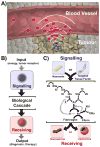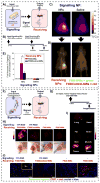Nanoparticles that communicate in vivo to amplify tumour targeting
- PMID: 21685903
- PMCID: PMC3361766
- DOI: 10.1038/nmat3049
Nanoparticles that communicate in vivo to amplify tumour targeting
Abstract
Nanomedicines have enormous potential to improve the precision of cancer therapy, yet our ability to efficiently home these materials to regions of disease in vivo remains very limited. Inspired by the ability of communication to improve targeting in biological systems, such as inflammatory-cell recruitment to sites of disease, we construct systems where synthetic biological and nanotechnological components communicate to amplify disease targeting in vivo. These systems are composed of 'signalling' modules (nanoparticles or engineered proteins) that target tumours and then locally activate the coagulation cascade to broadcast tumour location to clot-targeted 'receiving' nanoparticles in circulation that carry a diagnostic or therapeutic cargo, thereby amplifying their delivery. We show that communicating nanoparticle systems can be composed of multiple types of signalling and receiving modules, can transmit information through multiple molecular pathways in coagulation, can operate autonomously and can target over 40 times higher doses of chemotherapeutics to tumours than non-communicating controls.
© 2011 Macmillan Publishers Limited. All rights reserved
Figures





Comment in
-
Nanomedicine: swarming towards the target.Nat Mater. 2011 Jun 19;10(7):482-3. doi: 10.1038/nmat3060. Nat Mater. 2011. PMID: 21685899 No abstract available.
-
Nanotechnology: Tag teams.Nat Rev Cancer. 2011 Jul 14;11(8):537. doi: 10.1038/nrc3111. Nat Rev Cancer. 2011. PMID: 21753792 No abstract available.
Similar articles
-
Immune-modulating nanomedicines for enhanced drug delivery to non-small-cell lung cancer.Biomaterials. 2025 Jun;317:123089. doi: 10.1016/j.biomaterials.2025.123089. Epub 2025 Jan 3. Biomaterials. 2025. PMID: 39793167
-
Role of integrated cancer nanomedicine in overcoming drug resistance.Adv Drug Deliv Rev. 2013 Nov;65(13-14):1784-802. doi: 10.1016/j.addr.2013.07.012. Epub 2013 Jul 21. Adv Drug Deliv Rev. 2013. PMID: 23880506 Review.
-
Nanomedicine for targeted cancer therapy: towards the overcoming of drug resistance.Drug Resist Updat. 2011 Jun;14(3):150-63. doi: 10.1016/j.drup.2011.01.003. Epub 2011 Feb 16. Drug Resist Updat. 2011. PMID: 21330184 Review.
-
Targeting tumor microenvironment with RGD-functionalized nanoparticles for precision cancer therapy.Cancer Lett. 2025 Apr 1;614:217536. doi: 10.1016/j.canlet.2025.217536. Epub 2025 Feb 7. Cancer Lett. 2025. PMID: 39924081 Review.
-
New Strategies in Cancer Nanomedicine.Annu Rev Pharmacol Toxicol. 2016;56:41-57. doi: 10.1146/annurev-pharmtox-010715-103456. Epub 2015 Oct 28. Annu Rev Pharmacol Toxicol. 2016. PMID: 26514197 Review.
Cited by
-
MUC1-Targeted Cancer Cell Photothermal Ablation Using Bioinspired Gold Nanorods.PLoS One. 2015 Jul 6;10(7):e0128756. doi: 10.1371/journal.pone.0128756. eCollection 2015. PLoS One. 2015. PMID: 26147830 Free PMC article.
-
Selective Vaporization of Superheated Nanodroplets for Rapid, Sensitive, Acoustic Biosensing.Adv Healthc Mater. 2015 Aug 26;4(12):1790-5. doi: 10.1002/adhm.201500315. Epub 2015 Jun 17. Adv Healthc Mater. 2015. PMID: 26084414 Free PMC article.
-
The Evolution of Safe and Effective Coaguligands for Vascular Targeting and Precision Thrombosis of Solid Tumors and Vascular Malformations.Biomedicines. 2021 Jul 4;9(7):776. doi: 10.3390/biomedicines9070776. Biomedicines. 2021. PMID: 34356840 Free PMC article. Review.
-
Nanoparticle Probes for the Detection of Cancer Biomarkers, Cells, and Tissues by Fluorescence.Chem Rev. 2015 Oct 14;115(19):10530-74. doi: 10.1021/acs.chemrev.5b00321. Epub 2015 Aug 27. Chem Rev. 2015. PMID: 26313138 Free PMC article. Review.
-
Nanodiamonds: The intersection of nanotechnology, drug development, and personalized medicine.Sci Adv. 2015 Aug 21;1(7):e1500439. doi: 10.1126/sciadv.1500439. eCollection 2015 Aug. Sci Adv. 2015. PMID: 26601235 Free PMC article. Review.
References
-
- Chan WC, Nie S. Quantum dot bioconjugates for ultrasensitive nonisotopic detection. Science. 1998;281:2016–2018. - PubMed
-
- Xia YN, Halas NJ. Shape-controlled synthesis and surface plasmonic properties of metallic nanostructures. Mrs Bulletin. 2005;30:338–344.
-
- Gref R, et al. Biodegradable long-circulating polymeric nanospheres. Science. 1994;263:1600–1603. - PubMed
-
- Sengupta S, et al. Temporal targeting of tumour cells and neovasculature with a nanoscale delivery system. Nature. 2005;436:568–572. - PubMed
Publication types
MeSH terms
Substances
Grants and funding
LinkOut - more resources
Full Text Sources
Other Literature Sources

